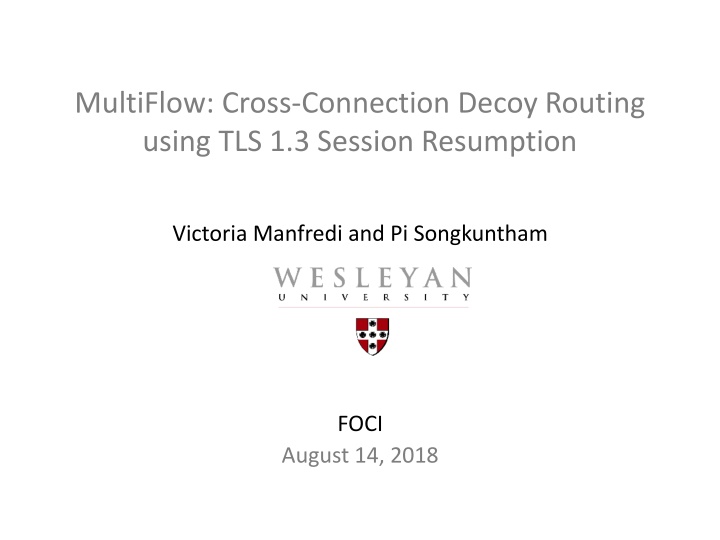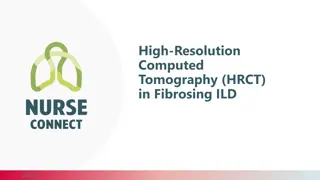
Innovative Decoy Routing Approach for Unblocking Websites
Explore the innovative Decoy Routing approach using MultiFlow, Cross-Connection, and TLS 1.3 Session Resumption to bypass filters and enhance online freedom. Addressing the limitations of traditional solutions like proxies, this method leverages decoy hosts to outsmart firewalls and provide access to blocked content effectively.
Download Presentation

Please find below an Image/Link to download the presentation.
The content on the website is provided AS IS for your information and personal use only. It may not be sold, licensed, or shared on other websites without obtaining consent from the author. If you encounter any issues during the download, it is possible that the publisher has removed the file from their server.
You are allowed to download the files provided on this website for personal or commercial use, subject to the condition that they are used lawfully. All files are the property of their respective owners.
The content on the website is provided AS IS for your information and personal use only. It may not be sold, licensed, or shared on other websites without obtaining consent from the author.
E N D
Presentation Transcript
MultiFlow: Cross-Connection Decoy Routing using TLS 1.3 Session Resumption Victoria Manfredi and Pi Songkuntham FOCI August 14, 2018
Motivation On the contemporary Internet, many sites are blocked or filtered Covert Host Filtering Firewall Client Adversary Network Outside
Current solutions Some users use proxies or VPNs to bypass filters Covert Host Filtering Firewall Proxy Site Client Adversary Network Outside
Problems with current solutions Using a proxy can attract unwanted attention Covert Host Filtering Firewall Proxy Site Client Someone is being sneaky! mage result for clipart spy Adversary Network Outside
Problems with current solutions and firewalls are getting better at blocking proxies Covert Host Filtering Firewall Proxy Site Client Adversary Network Outside
Decoy routing intuition Relies on (1) routers being much harder to block than hosts, and (2) existence of sites too (un)important to block Covert Host Filtering Firewall Client Decoy Host Any unblocked site Adversary Network Outside
Implementation Handshake: Client hides cryptographic signal in traffic sent to allowed host, DH. DR detects and responds to Client with its own cryptographic signal hidden in DH traffic Covert Host Filtering Firewall Decoy Router HTTP, HTTPS, TCP Client Decoy Host Any unblocked site Adversary Network Outside
Implementation Handshake: Client hides cryptographic signal in traffic sent to allowed host, DH. DR detects and responds to Client with its own cryptographic signal hidden in DH traffic Covert Host Filtering Firewall Decoy Router HTTP, HTTPS, TCP 035bc5c2149 Client Decoy Host Any unblocked site Adversary Network Outside
Implementation Handshake: Client hides cryptographic signal in traffic sent to allowed host, DH. DR detects and responds to Client with its own cryptographic signal hidden in DH traffic Covert Host Filtering Firewall Decoy Router HTTP, HTTPS, TCP 035bc5c2149 Client Decoy Host Any unblocked site dc783a5aa212 Adversary Network Outside
Implementation Tunnel: Client can now securely connect via DR to any IP address. Client DR hide their communication within Client DH traffic Covert Host Filtering Firewall Decoy Router HTTP, HTTPS, TCP Client Decoy Host Any unblocked site Adversary Network Outside
Implementation Tunnel: Client can now securely connect via DR to any IP address. Client DR hide their communication within Client DH traffic Covert Host Filtering Firewall Decoy Router HTTP, HTTPS, TCP Enc(CovRequest) Client Decoy Host Any unblocked site Adversary Network Outside
Implementation Tunnel: Client can now securely connect via DR to any IP address. Client DR hide their communication within Client DH traffic Covert Host Filtering Firewall Decoy Router HTTP, HTTPS, TCP Enc(CovRequest) Client Decoy Host Any unblocked site Adversary Network Outside
Implementation Tunnel: Client can now securely connect via DR to any IP address. Client DR hide their communication within Client DH traffic Covert Host Filtering Firewall Decoy Router HTTP, HTTPS, TCP Enc(CovRequest) Client Decoy Host Any unblocked site Enc(CovResponse) Adversary Network Outside
Assumptions Route asymmetry: DR sees only one direction of Client-DH traffic Covert Host Filtering Firewall Decoy Router HTTP, HTTPS, TCP Client Decoy Host Adversary Network Outside
Assumptions Adversary: can monitor, modify, block traffic to/from its network, but cannot see all traffic to/from DR, DH, CH Covert Host Filtering Firewall Decoy Router Client Decoy Host Adversary Network Outside
Assumptions Active attacks: Adversary can replay client traffic and probe Decoy Host, but cannot monitor internal activity of Client Covert Host Filtering Firewall Decoy Router Client Decoy Host Adversary Adversary Network Outside
Some problems 1. Inline blocking of traffic at DR is problematic for ISPs 2. DR forging/rewriting traffic provides attack surface 3. TLS termination attack affects only decoy routing connections 4. Rise of TLS 1.3
Some problems 1. Inline blocking of traffic at DR is problematic for ISPs Inline blocking 2. DR forging/rewriting traffic provides attack surface Passive tap TapDance [Wustrow et al, 2014]: passive tap but doesn t detect replay 3. TLS termination attack affects only decoy routing connections How to thwart replay attack with passive tap and asymmetric routes? 4. Rise of TLS 1.3
Some problems Forge: Cirripede [Houmansadr et al, 2011] Telex [Wustrow et al, 2011] Curveball [Karlin et al, 2011] TapDance [Wustrow et al, 2014] 1. Inline blocking of traffic at DR is problematic for ISPs Rewrite: Rebound [Ellard et al, 2015] Slitheen [Bocovich and Goldberg, 2016] Waterfall [Nasr et al, 2017] 2. DR forging/rewriting traffic provides attack surface Decoy Host Client Traffic analysis, latency, stack fingerprinting, probing attacks 3. TLS termination attack affects only decoy routing connections How to eliminate forging/rewriting by DR even with asymmetric routes? 4. Rise of TLS 1.3
Some problems 1. Inline blocking of traffic at DR is problematic for ISPs Firewall Enc(CovRequest) 2. DR forging/rewriting traffic provides attack surface Enc(CovResponse) Client What if adversary terminates connection after data exchanged on normal TLS connection? 3. TLS termination attack affects only decoy routing connections 4. Rise of TLS 1.3
Some problems 1. Inline blocking of traffic at DR is problematic for ISPs March 2018: IETF approves TLS 1.3 2. DR forging/rewriting traffic provides attack surface 3. TLS termination attack affects only decoy routing connections Acknowledgements: data collected by Daniel Ellard Browser support of TLS 1.3 4. Rise of TLS 1.3
MultiFlow protocol Step 1: Handshake Client signals to Decoy Router by setting TLS ClientRandom to appropriate string Decoy Router (passively observing) Signal 035bc5c2149 Client Decoy Host 035bc5c2149 035bc5c2149 Benefit: Lets Decoy Router authenticate Client as valid (but not necessarily live) user
MultiFlow protocol Step 2: Handshake Client exfiltrates its TLS session key and resumption info to Decoy Router Decoy Router (passively observing) 58b1a3dc46f Client Decoy Host 58b1a3dc46f TLS session key and resumption info 58b1a3dc46f Benefit: Decoy Router can fully impersonate Client with Decoy Host
MultiFlow protocol Step 3: Handshake Decoy Router resumes Client s session, opening new connection to Decoy Host Decoy Router (passively observing) Client Decoy Host Benefit: If resumable, then there exists a live Client even if adversary is replaying Client traffic
MultiFlow protocol Step 3: Handshake Decoy Router resumes Clients session, opening new connection to Decoy Host Client Decoy Host Handshake is complete! Benefit: If resumable, then there exists a live Client even if adversary is replaying Client traffic
MultiFlow protocol Step 4: Tunnel Client exfiltrates virtual message board info: e.g., HTTP POST to replay or email address Decoy Router (passively observing) Client Decoy Host a698de9c12 a698de9c12 POST /path HTTP/1.1 Host: decoy.com OR a698de9c12 client@reachable.com
MultiFlow protocol Step 5: Client exfiltrates request for Covert Host to Decoy Router on Client-Decoy Host connection HTTP POST Tunnel Covert Host Decoy Router (passively observing) 8ba3581dc1 Client Decoy Host 8ba3581dc1 GET / HTTP/1.1 Host: covert.com 8ba3581dc1
MultiFlow protocol Step 6: Decoy Router connects to Covert Host, sends Client request, gets response HTTP POST Tunnel Covert Host Decoy Router (passively observing) Client Decoy Host
MultiFlow protocol Step 7: Decoy Router replays Client POST but now (encrypted) covert response is payload HTTP POST Tunnel Covert Host POST /path Covert Response Decoy Router (passively observing) Client Decoy Host Decoy Response Benefit: Adversary never sees Decoy Router traffic, mitigates traffic analysis attacks
MultiFlow protocol Step 8: Client re-downloads info from POST path on its own connection HTTP POST Tunnel Covert Host Decoy Router (passively observing) GET /path Client Decoy Host GET /path HTTP/1.1 200 OK Covert response Benefit: Decoy Router does not forge or rewrite Client- Decoy Host traffic, mitigates probing attacks
MultiFlow protocol Step 8: Client re-downloads info from POST path on its own connection HTTP POST Tunnel Client Decoy Host Tunnel is complete! Benefit: Decoy Router does not forge or rewrite Client- Decoy Host traffic, mitigates probing attacks
MultiFlows (potential) implementation issues aka possible bad things I didn t talk about Session resumption Information leakage HTTP posted data Message board info Replaying posts Feasibility DR sending emails Decoy host collusion
Other ways to use MultiFlow protocol aka possible good things I didn t talk about Virtual symmetric routes Asynchronous comm. Cross-server decoy routing Tap-based authentication Combine with other DR protocols Virtual message-board
MultiFlow summary Decoy routing protocol design to address deployment issues Key ideas: Decoy Router resumes Client s TLS session, communicate via virtual message board Benefits: 1. Tap-based but checks client liveness 2. No DR forging/rewriting of traffic 3. Resists TLS termination attack 4. Designed for TLS 1.3 vumanfredi@wesleyan.edu ?? || /**/ https://victoriamanfredi.com






















